Dr. Crain’s Principles…
Dr. Craine's Brain Stimulation Principles
Dr. Craine liked to refer to the brain stimulation principles as the "Nuts and Bolts of neurotraining."
During the early years when Dr. Craine was creating his brain stimulation program, he found it necessary to develop a series of "working principles" or concepts. These stimulation principles were derived primarily from clinical practice, observation, and considerable trial-and-error over a 25-year period.
The following stimulation principles are the foundation upon which his brain rehabilitation program was built.
Today all effective brain stimulation follows these same principles. Once you know the "nuts and bolts"- you can apply them to any type of stimulation for your brain.
#1. Training specific Deficits. Proper stimulation is aimed at specific deficits.
This means the intent is to work directly with the most impaired areas of brain function.
The most common problem people experience, coined "senior moments" is a form of memory impairment.
Therefore- the 40+ pages of games included in my book focus on memory function.
#2. Active Stimulation. Active stimulation of a brain region requires activities that engage the brain cells in that region to respond to the exercise or demand placed upon them (e.g. remembering something) .
As this demand is increased- oxygenated blood and nutrients are sent to that region to strengthen and add connections between brain cell circuitry that is being used.
The old saying- Use it or Lose it applies here!
If you don't use (stimulate) brain cells- you lose brain cells and connections over time.
Therefore, it's important to point out that the brain needs to be engaged in the activity.
Watching TV is not considered active brain stimulation!
TV is passive stimulation. You get no brain stimulation or benefit- from watching TV.
#3. Programmed Stimulation. Put simply- programmed stimulation is an exercise plan.
For example: if your goal was to go to a gym and strengthen the muscles in your legs- a personal trainer would put you on an exercise plan that would gradually increase the demands placed upon the muscles in your legs.
This forces the muscles in the legs to adapt to the demand and become stronger.
The same principle holds true for brain training- by increasing the stimulation in a programmed manner- it forces your brain to adapt to the demand placed upon it.
The brain adapts by strengthening existing connections between brain cells and adding new connections to keep up with the demand.
#4. Enter training at the proper level. Before you can run you have to learn to walk- and before you can walk you have to learn to crawl. This basic concept applies to anything new that you are learning.
Dr. Craine refers to it as "finding your baseline" to establish the appropriate level that one should begin their training at.
Using the game "Ace to King" as an example, start at an easy number of cards and work your way up until you start making mistakes.
Then go back down just enough where you can remember all the cards without making any mistakes.
This is your baseline. This card number is where you start playing Ace to King.
#5. Ensure Successful Endeavors. How long do you continue playing a game when you never win at it?
Not very long I bet... That is why you need to start at a level where you can succeed! Keep it fun!
#6. Increase the level of difficulty in Small Increments. Have you ever taken a dance class or tried to run a marathon?
Can you imagine starting at the advanced level? No one would want to do that, so start at a level that you can manage and work your way up from there.
Increase the level of difficulty of the game or task you are doing in small increments and at regular intervals.
Start Ace to King at a level where you can succeed and slowly add a card until you can do all Ace to King.
These nuts and bolts apply to any type of brain stimulation you choose to integrate into your life to keep your brain healthy.
